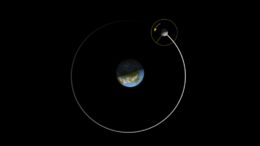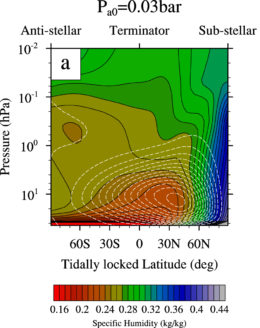Telescopes are getting better and better at detecting the components of exoplanet atmospheres. But what can those components tell us about a planet’s climate? It turns out that water vapor may be especially useful in this regard.
Atmospheres on Tidally-Locked Planets

The Moon orbiting the Earth, with a yellow arrow showing the direction of the Moon’s rotation. The Moon’s rotational period matches its orbital period so that the same face of the Moon faces Earth at all times. Click to play. [NASA’s Scientific Visualization Studio]
Just like our tidally locked Moon always shows the same face to the Earth, tidally locked planets always show the same face to their sun. So, a tidally locked planet will have a consistent dayside and nightside. This has fascinating implications for their climate, and even moreso when we consider that there could be tidally locked Earth-like planets!

A cross section of the planet’s atmosphere with a specific model pressure showing humidity with the colored contours and mass flow with the white contours. The nightside is on the left while the dayside is on the right. [Adapted from Ding & Pierrehumbert 2020]
To achieve nightside buildup of water vapor, the vapor must avoid being caught on the dayside in a “cold trap”, where it would be cooled, condense, and remain on the dayside. On a planet with inefficient cold trapping, the water vapor can be swept to the nightside to contribute to the thermal emission there.
This weak cold trap effect has mostly been modeled for planets with warm, thick atmospheres, but it is feasible for this effect to also occur on planets with thin, temperate atmospheres. A recent study done by Feng Ding (Harvard University) and Raymond Pierrehumbert (University of Oxford, UK) explores the second scenario for slowly rotating tidally locked planets.
Simulating Two Sides of a Planet

The brightness of the modeled planet as seen at a wavelength of 1,000 cm as it rotates. The different lines indicate different pressures and atmospheric conditions. The black vertical dashed line marks the superior conjunction, where the star is between the observer and the planet. Click to enlarge. [Adapted from Ding & Pierrehumbert 2020]
It turns out that thin, temperate atmospheres with weak cold traps do show the same nightside–dayside emission difference as warm, thick atmospheres as they approach the runaway greenhouse state! Interestingly, the difference between the nightside and dayside emissions can point to the relative amount of water vapor in a planet’s atmosphere as well as the atmospheric pressure — insight we can’t gain from the planet’s transmission spectrum. Further properties of a planet’s atmosphere can be determined by observing how the brightness of the planet changes as it rotates.
The subtleties from this study can’t be picked up by our telescopes yet, but possible future missions like the Origins Space Telescope may be able to. There’s no need to rush though: there are still lots more planets to simulate!
Citation
“The Phase-curve Signature of Condensible Water-rich Atmospheres on Slowly Rotating Tidally Locked Exoplanets,” Feng Ding and Raymond T. Pierrehumbert 2020 ApJL 901 L33. doi:10.3847/2041-8213/abb941

